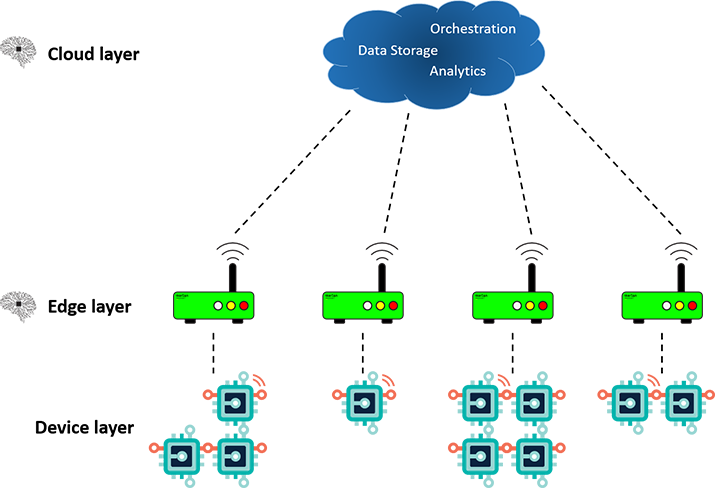Artificial Intelligence Leverages 3-layer IoT Architectures for the Next Industrial Revolution
Over the last years, the industrial ecosystem has experienced a paramount transformation. Significant research efforts have been devoted to optimizing and enriching Industry resources through advanced Artificial Intelligence (AI) tools. Obstacle detection, predictive maintenance, and quality control are well-known examples of the productivity improvements that AI yields for automotive, transportation, and cyber-physical manufacturing systems.
The reliability and performance of communications in these environments are even more critical for simultaneous dense dataflows, telemetry acquisition, and security policy compliance [1, 2]. Despite the massive computational capabilities of Cloud infrastructures, real-time applications are also constrained by roundtrip latency. Additionally, functional issues or anomalies at the Cloud side would lead to a set of disconnected IoT endpoints with no means to carry out their corresponding tasks.
In parallel to purely technical limitations, economical aspects need to be considered when evaluating the potential disadvantages of conventional Cloud approaches for industrial scenarios. In particular, the cost of lower communication performance, connectivity impairments, or Cloud failure is several orders of magnitude higher than in the case of average user applications [3].
In this regard, the 3-layer IoT paradigm brings Intelligence down to the Edge to overcome the most relevant drawbacks of conventional Cloud architectures. We focus on the remarkable benefits that can be achieved by IoT-Edge-Cloud deployments in three scenarios described hereinafter.

Figure 1: Example of 3-layer architecture for the Industrial IoT (IIoT).
The ever-growing public transportation networks for large metropolitan areas imply the transmission of vast amounts of data, associated with the implementation of obstacle detection techniques, scheduling, and user-side timetable tracking, among others. Specifically, the EU-funded ELASTIC Project [4] addresses the challenges of data analytics across the Florence tramway network. As abovementioned, advanced AI techniques require massive data acquisition, and hence the performance of a 2-tier IoT-Cloud strategy would be compromised. For this reason, the computational resources are distributed, with AI-enabled Edge devices deployed at tramway vehicles.
The acquired videos, GPS, and sensor samples cannot be entirely transmitted towards the Cloud, given that WLAN connectivity is only guaranteed at tram stops and LTE coverage could be limited at several points across the line. On the contrary, the software architecture provides the system with a distributed data analytics platform capable of performing highly demanding computational tasks at the Edge. Analogously, data storage and accessibility are also handled by a distributed database [5]. Consequently, a set of non-functional requirements (NFR) need to be fulfilled in such a way that efficiency, data coherence, and robustness is ensured across the network. For this purpose, additional tools are included to monitor real-time attributes, energy consumption, cybersecurity, and communication latency [6]. Whenever one or more of these parameters falls out of scope, the NFR tool indicates the orchestrator [7] to re-schedule computational loads among the different Edge devices, in such a way that the entire system keeps working as expected.
On the other hand, many applications in the Industry sector require an entire fleet of connected devices to be managed. One of the main aspects to consider in such cases is software version control and updates. When the number and location diversity of devices scales, on-site manual updates are not feasible, and therefore more sophisticated approaches are developed. A remarkable example is the software version control toolchain within the context of the Arrowhead Tools EU-funded Project [8]. The idea behind this solution is to carry out a sequence that checks the current versions of the software tools running on every device in the system. The Edge devices report the obtained versions whereas, on the other hand, the most recent available versions and requirements are listed in the Cloud. Back at the Edge layer, every device ensures that the requirements for new versions are fulfilled, and if so, pull the new versions for validation. When the validation tests are successful, then the new versions are deployed. In short, the update procedure can be executed with more information about the corresponding devices, and validation tasks are offloaded from Cloud to Edge and performed over real deployments remotely.
Also, 3-layer schemes enhance field monitoring and validation for control networks in cyber-physical systems [9]. For instance, as one of the use-cases in the ADEPTNESS project [10], a control area network (CAN) bus connecting several IoT devices can be monitored from an Edge node. Then, regarding a given specification, relevant functional variables are reported periodically in such a way that normal operation of the system is continuously tracked. With this information, any outlying behavior would be detected. Furthermore, the monitoring specification and any other application running on the Edge endpoints can be updated and validated in a distributed, transparent manner, i.e., following the continuous integration/continuous deployment (CI/CD) lines [11].
As an outcome, industrial markets such as smart elevation, railway transportation, and manufacturing can benefit from switching to multilevel distributed approaches on a very short-term basis. These 3-layer IoT-Edge-Cloud architectures play a crucial role when transferring the aforementioned advances towards Industry 4.0.
References
- H. Chaouchi, T. Bourgeau, “Internet of Things: Building the New Digital Society,” IoT, vol. 1(1), pp. 1-4, June 2018.
- P. Li, J. Su, X. Wang, “iTLS: Lightweight Transport Layer Security Protocol for IoT with Minimal Latency and Perfect Forward Secrecy,” IEEE Internet of Things Journal, vol. 7(8), pp. 6828-6841, April 2020.
- M. Yao. in Forbes (2017, Apr. 14). 4 Unique Challenges Of Industrial Artificial Intelligence [Online]. Available: https://bit.ly/32spLQu
- ELASTIC: A Software Architecture for Extreme-Scale Big-Data Analytics in Fog Computing Ecosystems. European Union Horizon 2020 research and innovation programme, grant agreement no. 825473. Available: https://bit.ly/2U63Vhf
- J. Martí, A. Queralt, D. Gasull, A. Barceló, J. J. Costa, T. Cortes, “Dataclay: A distributed data store for effective inter-player data sharing,” Journal of Systems and Software, vol. 131, pp. 129-145, September 2017.
- A. Orive, A. Agirre, J. Bilbao, M. Marcos, “Passive Network State Monitoring for Dynamic Resource Management in Industry 4.0 Fog Architectures,” in 14th IEEE International Conference on Automation Science and Engineering (CASE), Munich, Germany, 2018, pp. 1414-1419.
- R. M. Badia, J. Conejero, C. Diaz, J. Ejarque, D. Lezzi, F. Lordan, C. Ramon-Cortes, R. Sirvent, “COMP Superscalar, an interoperable programming framework,” Software X, vol. 3-4, pp. 32-36, December 2015.
- Arrowhead Tools. ECSEL Joint Undertaking (JU) – European Union Horizon 2020 research and innovation programme and Norway and Switzerland, grant agreement no. 826452. Available: https://bit.ly/38q3Zkq
- G. Peralta, M. Iglesias-Urkia, M. Barcelo, R. Gomez, A. Moran, J. Bilbao, “Fog computing based efficient IoT scheme for the Industry 4.0,” in IEEE International Workshop of Electronics, Control, Measurement, Signals and their Application to Mechatronics (ECMSM), Donostia – San Sebastian, Spain, 2017, pp. 117-122.
- ADEPTNESS: Automating the design-operation continuum of Cyber Physical Systems of Systems. European Union Horizon 2020 programme for research, technological development and demonstration, grant agreement no. 871319. Available: https://bit.ly/2GGoxJP
- M. Shahin, M. A. Babar, L. Zhu, “Continuous Integration, Delivery and Deployment: A Systematic Review on Approaches, Tools, Challenges and Practices,” IEEE Access, vol. 5, pp. 3909-3943, March 2017.
 Jacobo Fanjul received his Telecommunication Engineering (M.Sc.) degree from the University of Cantabria, Santander, Spain, in 2014. In 2013, he joined the Department of Communications Engineering, University of Cantabria, where he focused on advanced signal processing techniques for wireless communications. During 2016, he was a visiting researcher at the Department of Electrical Engineering and Computer Science (EECS), University of California, Irvine. Shortly afterwards, he was a visiting researcher at the Multimedia Communications Laboratory, the University of Texas at Dallas. In 2019, he received his Ph.D. in Information and Communication Technologies for Mobile Networks, and he joined IKERLAN Technology Research Centre (Basque Research and Technology Alliance, BRTA) as an R&D Engineer on IoT & Digital Platforms.
Jacobo Fanjul received his Telecommunication Engineering (M.Sc.) degree from the University of Cantabria, Santander, Spain, in 2014. In 2013, he joined the Department of Communications Engineering, University of Cantabria, where he focused on advanced signal processing techniques for wireless communications. During 2016, he was a visiting researcher at the Department of Electrical Engineering and Computer Science (EECS), University of California, Irvine. Shortly afterwards, he was a visiting researcher at the Multimedia Communications Laboratory, the University of Texas at Dallas. In 2019, he received his Ph.D. in Information and Communication Technologies for Mobile Networks, and he joined IKERLAN Technology Research Centre (Basque Research and Technology Alliance, BRTA) as an R&D Engineer on IoT & Digital Platforms.
 Álvaro González-Vila received his M.Sc. degree in Telecommunication Engineering in 2014 from the University of Cantabria, Spain. He then obtained his Ph.D. degree in Engineering Science and Technology in 2019 from the University of Mons, Belgium, being his research focused on advanced coatings for optical fiber sensors. He was the holder of a FRIA grant from the Belgian F.R.S.-FNRS from 2015 to 2019. During 2018, he was a visiting researcher at the Institute of Photonics Technology, Jinan University, Guangzhou, China. He is an Early Career Member of the OSA and SPIE. In 2020 he joined IKERLAN Technology Research Centre (Basque Research and Technology Alliance, BRTA) as an R&D Engineer on IoT & Digital Platforms.
Álvaro González-Vila received his M.Sc. degree in Telecommunication Engineering in 2014 from the University of Cantabria, Spain. He then obtained his Ph.D. degree in Engineering Science and Technology in 2019 from the University of Mons, Belgium, being his research focused on advanced coatings for optical fiber sensors. He was the holder of a FRIA grant from the Belgian F.R.S.-FNRS from 2015 to 2019. During 2018, he was a visiting researcher at the Institute of Photonics Technology, Jinan University, Guangzhou, China. He is an Early Career Member of the OSA and SPIE. In 2020 he joined IKERLAN Technology Research Centre (Basque Research and Technology Alliance, BRTA) as an R&D Engineer on IoT & Digital Platforms.
 Jose Ramón Juarez received his M.Eng. degree in Telecommunication Engineering in 2004 from the University of the Basque Country (UPV/EHU), Spain. He obtained his Ph.D. degree in 2011 from the Public University of Navarre, Spain, through the program “Technologies for distributed management of information”. During this period, he held an Assistant Lecturer position in the Computing Systems and Languages Department, and he was a member of the Distributed Systems Group at the Public University of Navarre, Spain. He was a visiting researcher at the University of Minho, Braga, Portugal, and at the University of Lugano, Switzerland. After working for several companies from the private sector, he is currently the leader of the IoT & Digital Platforms research group at IKERLAN Technology Research Centre. His main interests comprise high-availability systems, dynamic and adaptative distributed systems, machine learning, wireless communications, 5G, lightweight protocols, fog-edge-cloud architectures, and software analysis and testing.
Jose Ramón Juarez received his M.Eng. degree in Telecommunication Engineering in 2004 from the University of the Basque Country (UPV/EHU), Spain. He obtained his Ph.D. degree in 2011 from the Public University of Navarre, Spain, through the program “Technologies for distributed management of information”. During this period, he held an Assistant Lecturer position in the Computing Systems and Languages Department, and he was a member of the Distributed Systems Group at the Public University of Navarre, Spain. He was a visiting researcher at the University of Minho, Braga, Portugal, and at the University of Lugano, Switzerland. After working for several companies from the private sector, he is currently the leader of the IoT & Digital Platforms research group at IKERLAN Technology Research Centre. His main interests comprise high-availability systems, dynamic and adaptative distributed systems, machine learning, wireless communications, 5G, lightweight protocols, fog-edge-cloud architectures, and software analysis and testing.
 Josu Bilbao (IEEE Senior Member) obtained the Telecommunication Engineering degree from the Faculty of Engineering of Bilbao (UPV/EHU), the M.Sc. degree in Communications and Control from the University of the Basque Country (UPV/EHU), and the Ph.D degree in Computer Science from the University of Navarra. He currently leads the ICT (Information and Communication Technologies) research department at IKERLAN, a private research center leader in technology transference and part of MONDRAGON Corporation. He leads the department composed of 2 research groups: “IoT & Digital Platforms” research group; and “Data Analytics & Artificial Intelligence” research group.
Josu Bilbao (IEEE Senior Member) obtained the Telecommunication Engineering degree from the Faculty of Engineering of Bilbao (UPV/EHU), the M.Sc. degree in Communications and Control from the University of the Basque Country (UPV/EHU), and the Ph.D degree in Computer Science from the University of Navarra. He currently leads the ICT (Information and Communication Technologies) research department at IKERLAN, a private research center leader in technology transference and part of MONDRAGON Corporation. He leads the department composed of 2 research groups: “IoT & Digital Platforms” research group; and “Data Analytics & Artificial Intelligence” research group.
He plays an active role in different standardization committees and development of industrial products, and his current research interests span several fields such as IoT and IIoT, real-time CPS integration in the IoT, Cloud and Fog-based architectures, Artificial Intelligence, Edge computing and 5G among others.
Sign Up for IoT Technical Community Updates
Calendar of Events
IEEE 8th World Forum on Internet of Things (WF-IoT) 2022
26 October-11 November 2022
Call for Papers
IEEE Internet of Things Journal
Special issue on Towards Intelligence for Space-Air-Ground Integrated Internet of Things
Submission Deadline: 1 November 2022
Special issue on Smart Blockchain for IoT Trust, Security and Privacy
Submission Deadline: 15 November 2022
Past Issues
September 2022
July 2022
March 2022
January 2022
November 2021
September 2021
July 2021
May 2021
March 2021
January 2021
November 2020
July 2020
May 2020
March 2020
January 2020
November 2019
September 2019
July 2019
May 2019
March 2019
January 2019
November 2018
September 2018
July 2018
May 2018
March 2018
January 2018
November 2017
September 2017
July 2017
May 2017
March 2017
January 2017
November 2016
September 2016
July 2016
May 2016
March 2016
January 2016
November 2015
September 2015
July 2015
May 2015
March 2015
January 2015
November 2014
September 2014


